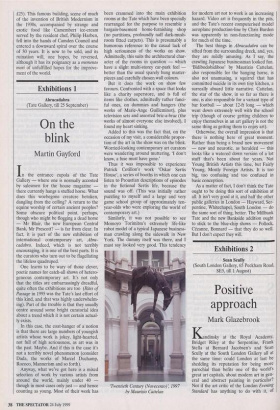Exhibitions 1
Abracadabra (Tate Gallery, till 25 September)
On the blink
Martin Gayford
In the entrance cupola of the Tate Gallery — where one is normally accosted by salesmen for the house magazine there currently hangs a stuffed horse. What does this woebegone creature betoken, dangling from the ceiling? A return to the equine worship of certain ancient peoples? Some obscure political point, perhaps, though who might be flogging a dead horse — Mr Blair, the new European Central Bank, Mr Prescott? — is far from clear. In fact, it is part of the new exhibition of international contemporary art, Abra- cadabra. Indeed, which is not terribly encouraging, it is one of the best parts. It is the curators who turn out to be flagellating the lifeless quadruped.
One learns to be wary of those clever, poetic names for catch-all shows of hetero- geneous contemporary art. It's not only that the titles are embarrassingly dreadful, quite often the exhibitions are too (Rites of Passage in 1995 was the Tate's last effort of this kind, and that was highly underwhelm- ing). Part of the trouble is that they usually centre around some bright curatorial idea about a trend which it is not certain actual- ly exists.
In this case, the coat-hanger of a notion is that there are large numbers of youngish artists whose work is jokey, light-hearted, not full of high seriousness, as art was in the past. Maybe. And if this is the case it's not a terribly novel phenomenon (consider Dada, the works of Marcel Duchamp, Rococo, Mannerism and so forth).
Anyway, what we've got here is a mixed selection of work by various artists from around the world, mainly under 40 though in most cases only just — and hence counting as young. Most of their work has been crammed into the main exhibition rooms at the Tate which have been specially rearranged for the purpose to resemble a bargain-basement home-furnishing shop (no partitions, profoundly naff dark-mush- room fitted carpets). This is presumably a humorous reference to the casual lack of high seriousness of the works on show. Admittedly, this suits the architectural char- acter of the rooms in question — which have a slight multi-storey car-park feel better than the usual sparely hung master- pieces and carefully chosen wall colours.
But it does the work on show few favours. Confronted with a space that looks like a charity superstore, and is full of items like clothes, admittedly rather fanci- ful ones, on dummies and hangers (the works of Marie-Ange Guilleminot), plus television sets and assorted bric-a-brac (the works of almost everyone else involved), I found my heart sinking.
Added to this was the fact that, on the occasion of my visit, a considerable propor- tion of the art in the show was on the blink. Worried-looking contemporary art curators were wandering around muttering, 'I don't know, a fuse must have gone.'
Thus it was impossible to experience Patrick Cotillon's work 'Oskar Sertis House', a series of booths in which one can listen to Proustian descriptions of episodes in the fictional Sertis life, because the sound was off. (This was initially rather puzzling to myself and a large and very game school group of approximately ten- year-olds who were exploring the world of contemporary art.) Similarly, it was not possible to see Momoyo Torimitsu's extremely life-like robot model of a typical Japanese business- man crawling along the sidewalk in New York. The dummy itself was there, and I must say looked very good. This tendency `Twentieth Century (Novecento), 1997 by Maurizio Cattelan for modem art not to work is an increasing hazard. Video art is frequently in the pits, and the Tate's recent computerised model aeroplane production-line by Chris Burden was apparently in non-functioning mode for much of the time.
The best things in Abracadabra can be sifted from the surrounding dreck, and, yes, they are mildly amusing. As I say, the crawling Japanese businessman looked fun. `Bidibodobidiboo' by Maurizio Cattelan, also responsible for the hanging horse, is also not unamusing, a squirrel that has committed suicide in its own tiny kitchen, a surreally absurd little narrative. Cattelan, the star of the show, in so far as there is one, is also responsible for a variant type of bar football — about 12-ft long — which went down extremely well with the school trip (though of course getting children to enjoy themselves in an art gallery is not the same thing as getting them to enjoy art).
Otherwise, the overall impression is that there is nothing here of great moment. Rather than being a brand new movement — new and neurotic, as heralded — this looks like a watered down version of a lot stuff that's been about for years. Not Young British Artists this time, but Fairly Young, Mostly Foreign Artists. It is too big, too confusing and too confused in basic conception.
As a matter of fact, I don't think the Tate ought to be doing this sort of exhibition at all. It isn't very good at it, and half the other public galleries in London — Hayward, Ser- pentine, Whitechapel, South London — do the same sort of thing, better. The Millbank Tate and the new Bankside addition ought to stick to the blue-chip shows — Pollock, Cezanne, Bonnard — that they do so well. But I don't expect they will.


























































 Previous page
Previous page